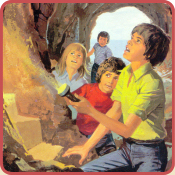
The Enid Blyton Nature Readers (No. 2)

Book Details...
First edition: 1945
Publisher: Macmillan
Illustrator: Eileen A. Soper
Category: The Enid Blyton Nature Readers
Genre: Nature
Type: Readers
Publisher: Macmillan
Illustrator: Eileen A. Soper
Category: The Enid Blyton Nature Readers
Genre: Nature
Type: Readers
On This Page...
- The Squirrel Who Forgot
Story: Specially Written - Jack Frost is About
Story: Specially Written
Nature plates, illustrated by Eileen A. Soper


The Squirrel Who Forgot

Enid Blyton has used the word 'forgettery' more than once and it amply describes Bushy's 'memory.' Bobtail reprimands him about it because squirrels need satisfactory retention abilities if only to recall where their winter store of nuts is hidden.
In this particular case Bushy can't remember where his recently built home is placed and that's a bit off because if you spend some considerable time constructing an abode with twigs, moss, leaves, and whatever else, surely you'd remember where it is. Fortunately Bobtail, who'd observed him on and off, knows the location and is able to lead the forgetful squirrel to his residence. Bushy is delighted and immediately makes a resolve.
"I will really try to remember things in the future."
Summer passes. Bushy scampers up and down trees, plays with other squirrels and talks to the birds as well as to many of his rabbit friends but most importantly, he remembers where his resting place is, so is there anything more to be said? Well, yes there is because autumn arrives and Bobtail questions Bushy as to whether he'll sleep the winter away like frogs and toads do. The squirrel tells him,
"I think I will sleep when it's very, very cold."
After all he doesn't want to miss the odd patches of sunny weather and he, like Bobtail, thinks the frogs and snakes are silly not to wake up during any warm spells that might eventuate. Bobtail wonders if Bushy will need any food seeing he'll be asleep most of the time and the little squirrel tells him 'yes'. Like all of his kind he'll store some provisions away for future use; and now Bushy becomes very busy indeed collecting up all kinds of seeds and nuts to hide in various places - a hole in the hollow tree, another in a bank, and so on.
That night the frost arrives and Bushy curls himself up to sleep soundly in his hideaway until one day, in the middle of winter and after a period of rain, the temperature becomes a few degrees warmer. Bushy wakes up and decides that conditions are ripe for a little fling but first he needs some breakfast. Enid Blyton has written several stories about squirrels who forget where they've stored their food, so is this to be another such tale?
Unfortunately 'Yes.' Poor Bushy can't locate his rations despite hunting everywhere. He's dying to put his teeth into the shell of a nut but it looks as if this is not about to happen because he can't remember where any single item of his food is hidden, and Bobtail's no where around so he can't be asked either. At this point, another squirrel enters the story ... a female named Frisky and all in all, a very happy arrangement is made between her and Bushy.
Jack Frost is About
He is indeed and there he stands on a bare windy hillside surveying the winter landscape and slapping himself hard on the chest.
"How strong I am. With a little help from the wind, we've stripped the trees of all their leaves and now they stand, bare, brown, and dead!"
A passing owl queries this remark, but Jack Frost shouts up to him.
"Well, look. Not a leaf to be seen anywhere ... I've killed them all!"
"You haven't killed them all," hoots the owl as he flies round Jack Frost's head, nodding towards the glossy, prickly leaves and scarlet berries of a nearby tree. Jack Frost has to admit that those particular leaves won't fall as the beech, poplar, and hazel ones have. No, the holly tree is an exception and so are the yews, the pines, and the fir trees.
The owl flies off hooting one last time at Jack's statement that he's managed to kill most of the other trees.
"I think you're wrong. You haven't killed them."
Jack Frost moves down the hill with his icy breath freezing everything before him and his cold fingers nipping the noses and feet of any animal he meets. All winter he stands amongst the bare trees, believing that soon the woodmen will appear to chop them all down.
The owl returns one day to inform him again that he was wrong - no tree has been killed by him, and he tells Jack to put his head against a chestnut tree and listen. He does so and sure enough the sap is heard rising once again - passing life into every bud and strengthening the tiny folded leaves inside.
Jack Frost is not happy. His perceived mission is to destroy, destroy, and destroy so he decides the buds must be killed there and then.
"No tree can live without leaves. I will pinch the buds and kill them."
He breathes his cold breath over the chestnut tree's buds and strokes them with his icy fingers ... deadly digits that can kill whatever they touch.
Returning the following night he receives a shock. The buds are thriving, in fact they're even a little bigger. What then follows of course are Blyton explanations as to why the trees are surviving despite Jack Frost's best destructive efforts.
#1: Bobtail is of course, a rabbit.
Enid Blyton covered the list of failings with which children and animals are often afflicted, and in this particular story its all about the tendency to 'forget.' The general stance seemed to be that any habit which causes us personal annoyance can be placed in the same class as outright acts of disobedience and other 'crimes.' Some of the 'naughty' children in EB's collection of tales have been not only boasters, bullies, meddlers, greedy pigs, stone throwers, careless kids, and promise breakers, but the list also includes nail-biters, a girl that didn't walk properly (Miss Waddle Toes), an inquisitive boy, silly children, and even 'leaners' such as a girl called Lucy who was always 'lolling about.' "The Boy Who Was Too Clever" is also classed as a 'naughty' child although he might simply have been trying to make the best out of his once-in-a-lifetime chance.
Other stories that have a 'forgetting' theme:
'The Very Forgetful Gnome.'
'She Lost her Memory.' Dolly loses her memory as in - loses her 'actual' memory.
'She Forgot to say Thank You.' Lucy is invited to a Brownie's two hundred and thirty third birthday but forgets her manners.
'Mr. Twiddle Forgets.' In this chap's case, forgetfulness is what he's all about.
'He Didn't Remember.' Forgetting his shoes costs Bob some good money.
'Forgetful Fanny.' This girl's 'forgettery' utterly destroys her ninth birthday party.
'Fred's Forgettery.' Fred's affliction causes his schoolmates to miss a rip-roaring treat.
In line with the booklets' instructive aims, there are close-up pictures of 'beech mast' (what on earth is that?), pine cones, and hazel nuts.
'Helping one another and loving one another are the nicest things in the world," said Frisky, cuddling down into her cosy nest with their three furry babies.
#2: Our author has made several references to Jack Frost, who could be described as the 'personification of winter.' This story's depiction of him would run reasonably close to our idea as to his appearance - a gnome-like figure with the appropriate garb that includes one of those Santa-Claus type hats. He also has a beard and, in this case, Soper has added a long nose.
An interesting revelation comes at the end and it's to do with the plane tree. Jack Frost prepares to kill its tender buds with his cold fingers but there aren't any to be seen. Where might they be? The owl tells him where, and his explanation for revealing their location to a killer of such proportions is in the following passage:
"I'll tell you where they are. It won't matter my telling you, because you will never be able to get at the buds in the autumn when they are weak and tender. Now they are strong, and you cannot hurt them."
Countless EB tales describe nature's methods in analogous form and a couple of books that come to mind are the ones that star Pip the Pixie.
Two-tone colours (orange and green) add even more to the illustrations. The covers all have the same picture which is a pity because this series could have displayed thirty different Eileen Soper pictures which would have been a bonus. "I'll Tell You A Story" and it's companion also have the same wrapper illustration - one that tends to show Soper at her best.








